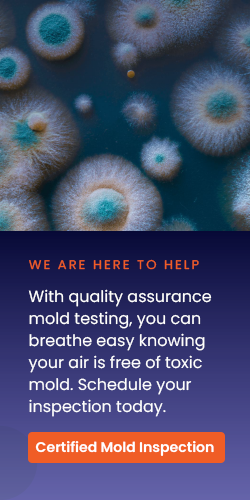Getting The Amazinghazardremoval.com Mold Testing Fairfield To Work
Getting The Amazinghazardremoval.com Mold Testing Fairfield To Work
Blog Article
Amazinghazardremoval.com Mold Testing Fairfield Fundamentals Explained
Table of ContentsAmazinghazardremoval.com Mold Testing Fairfield Fundamentals ExplainedThe smart Trick of Amazinghazardremoval.com Mold Testing Fairfield That Nobody is Talking AboutThe 7-Second Trick For Amazinghazardremoval.com Mold Testing FairfieldThe Definitive Guide to Amazinghazardremoval.com Mold Testing FairfieldAmazinghazardremoval.com Mold Testing Fairfield Fundamentals ExplainedOur Amazinghazardremoval.com Mold Testing Fairfield Statements
Unless you're careful, you might interrupt the mold and mildew growth and release spores throughout your building. At Paul Sakson Environmental, we offer specialist mold testing and removal solutions to household, industrial, and kid treatment facilities throughout New Jersey.With us, you won't need to fret exactly how your indoor air top quality is affecting your loved ones. To learn more, contact us today!.
1.1 The purpose of this requirement is to offer standardized treatments to be used for a mold and mildew assessment. There are two types of mold assessments explained in the IAC2 Mold Assessment Requirements of Method: (1) Total Mold Inspection (Area 2.0)( 2) Restricted Mold Evaluation (Area 3.0) 1.2 Unless the inspector and client consent to a restriction of the inspection, the examination will certainly be carried out at the primary structure and connected parking structure.
1.3 A mold and mildew examination stands for the day of the examination and can not forecast future mold growth. Due to the fact that problems conducive to mold and mildew development in a building can vary considerably with time, the outcomes of a mold inspection (exam and sampling) can just be relied upon for the point in time at which the evaluation was conducted.
The Amazinghazardremoval.com Mold Testing Fairfield Diaries

The limited mold assessment does not consist of a visual examination of the whole structure, however is limited to a specific location of the building identified and defined by the inspector. Because of this, wetness intrusion, water damages, mildewy smells, evident mold and mildew development, or problems helpful to mold growth in various other areas of the building may not be inspected.
The roofing covering. B. The roofing drain system, consisting of gutters and downspouts. C. The vents, flashings, skylights, smokeshafts, and any kind of other roofing penetrations. II. The examiner is not needed to: A. Walk on any roof covering more info here surface. B. Predict the service life span. C. Perform a water test. 4.2 Outside and Grounds I.
Fascination About Amazinghazardremoval.com Mold Testing Fairfield
The cladding, blinking and trim. B. Outside doors, windows, decks, stoops, actions, stairs, patios, railings, eaves, soffits and fascias. C. The outside grading bordering the building boundary. D. Products that penetrate the outside home siding or covering materials. II. The assessor is not called for to: A. Inspect underground water drainage systems. B.
Inspect defects not connected to mold and mildew growth or wetness breach. 4.3 Basement, Structure, Crawlspace, and Framework I. The inspector will evaluate: A. The structure, basement, or crawlspace including air flow. AmazingHazardRemoval.com Mold Testing Fairfield. B. For moisture breach II. The examiner is not needed to: A. Operate sump pumps with inaccessible floats. B. Inspect for structural problems not associated to mold and mildew growth or moisture invasion.
The Only Guide to Amazinghazardremoval.com Mold Testing Fairfield
The examiner will check: A - AmazingHazardRemoval.com Mold Testing Fairfield. The air trainer, circulating follower, and air filter. B. The condensate pump. C. Conveniently noticeable ductwork. D. Representative number of supply and return air signs up. E. The main humidifier. F. The central air system. II. The inspector is not called for to: A. Check the a/c coil if not easily accessible.
Examine the condensate frying pan otherwise readily easily accessible. C. index Examination the efficiency or effectiveness of the HVAC system. D. Inspect the interior of ductwork system. 4.5 Plumbing I. The assessor shall evaluate: A. The easily visible major water line. B. The conveniently noticeable supply of water lines. C. The readily noticeable drain, waste, and air vent pipelines.
Warm water resource. E. Fixtures such as toilets, taps, showers and tubs. II. The examiner is not required to: A. Test the showers and bathtubs by loading them with waterB. Examination whirlpool bathtubs, saunas, steam bath, or jacuzzis. C. Inspect for pipes problems that are not connected to mold growth or dampness breach.
The examiner will examine: A. Insulation. The inspector is not called for to: A. To relocate, touch, or article interrupt insulation. B. Inspect for vapor retarders.
A Biased View of Amazinghazardremoval.com Mold Testing Fairfield
The assessor shall check: A. The assessor is not called for to: A. Inspect for interior flaws that are not connected to mold and mildew growth or moisture intrusion. 4.8 Wetness, Humidity, and Temperature I.
Moisture of wetness room any type of space of location building that structure moisture intrusionDampness invasion damage, damages odors, apparent mold obvious, or conditions conducive problems mold growthMold and mildew
The focus of mold inside a home need to not be greater than the concentration of mold exterior. Mold and mildew spores in the air being tasted can vary greatly in relation to the life cycle of the mold, atmospheric and ecological conditions, and the amount of air flow.
The Main Principles Of Amazinghazardremoval.com Mold Testing Fairfield
Air sampling might be necessary if the mold growth is thought (for instance, stuffy smells), but can not be identified by a visual assessment. The function of such air tasting is to determine the location and/or level of mold and mildew contamination as well as an easy confirmation that mold and mildew development exists somewhere in the structure.
Report this page